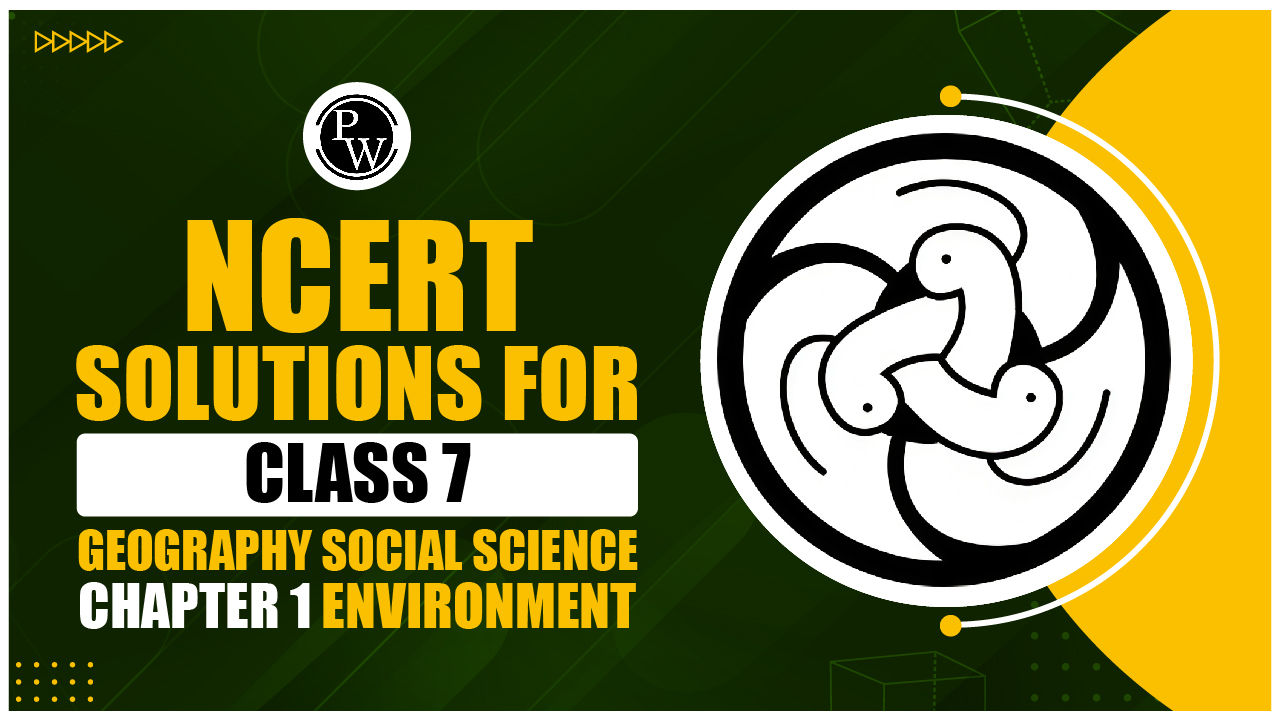NCERT Solutions For Class 7 Geography Social Science Chapter 1 Environment

Class 7 Geography Chapter 1:- In the first chapter of Class 7 Geography, titled "Environment," we explore the fundamental concepts that shape our world. This chapter introduces students to the environment as a complex and interconnected system comprising both natural and human-made components. It emphasizes the importance of understanding how living organisms, including plants and animals, interact with their surroundings, including air, water, and land. Check the Class 7 Geography Chapter 1 below.
Check out: Class 7th Books
Class 7 Geography Chapter 1 Questions and Answers
Q 1. Answer the following questions.
(i) What is an ecosystem?
Answer: An ecosystem is a complex network or system formed by the interaction of living organisms (such as plants, animals, and microorganisms) with each other and with the physical and chemical components of their environment (such as soil, water, and climate). In an ecosystem, energy flows through different organisms via food chains and webs, and materials cycle between the living and non-living components. This interconnectedness ensures the survival and balance of the ecosystem, making it a self-sustaining and dynamic entity.
(ii) What do you mean by natural environment?
Answer: The natural environment encompasses all the natural components and processes that exist on Earth without human intervention. This includes the land (geosphere), water (hydrosphere), air (atmosphere), and all living organisms (biosphere). These components work together in a balanced and harmonious manner, supporting various ecosystems. The natural environment also includes natural phenomena such as weather, climate, and geological activities like earthquakes and volcanic eruptions. It forms the foundation for all life on Earth and provides essential resources such as clean air, water, and fertile soil.
(iii) Which are the major components of the environment?
Answer: The environment consists of three major components:
-
Natural Components: These include the physical elements such as air (atmosphere), water (hydrosphere), land (lithosphere), and all living organisms (biosphere). These components form the basic framework of the environment and are essential for sustaining life on Earth.
-
Human-made Components: These are elements that have been created or significantly altered by human activities. Examples include buildings, roads, dams, industries, and other infrastructure. These components are designed to meet human needs and improve living standards but can also impact the natural environment.
-
Human Components: This refers to the human population, its activities, and social structures. It includes cultural, social, economic, and political aspects that influence how humans interact with both natural and human-made components of the environment.
(iv) Give four examples of a human-made environment.
Answer: Four examples of a human-made environment are:
-
Buildings: Structures constructed for residential, commercial, or industrial purposes. They provide shelter and spaces for various human activities.
-
Parks: Designed and maintained green spaces that offer recreation, aesthetic value, and environmental benefits within urban settings.
-
Industries: Factories and manufacturing plants where goods are produced. They are central to economic development but often contribute to environmental pollution.
-
Bridges: Structures built to span physical obstacles like rivers or roads, facilitating transportation and connectivity.
(v) What is lithosphere?
Answer: The lithosphere is the rigid outermost layer of the Earth, comprising the crust and the upper part of the mantle. It is the solid, rocky shell that makes up the Earth's surface and is where most geological activities like mountain formation, earthquakes, and volcanic eruptions occur. The lithosphere is made up of tectonic plates that float on the semi-fluid asthenosphere beneath them. These plates' movement shapes the Earth's landscape, creating landforms such as mountains, plateaus, and plains. The lithosphere is also where soils form, supporting plant life and providing the foundation for human infrastructure.
(vi) Which are the two major components of the biotic environment?
Answer: The two major components of the biotic environment are:
-
Plants: These are the primary producers in most ecosystems, meaning they produce their own food through photosynthesis and provide energy and nutrients to other organisms (consumers). Plants also help regulate the atmosphere by absorbing carbon dioxide and releasing oxygen.
-
Animals: These are the consumers in an ecosystem, feeding on plants or other animals. Animals play various roles, such as herbivores, carnivores, omnivores, and decomposers, contributing to energy transfer and nutrient cycling within the ecosystem.
(vii) What is a biosphere?
Answer: The biosphere is the global sum of all ecosystems, representing the zone of life on Earth. It is the narrow band around the Earth's surface where land (lithosphere), water (hydrosphere), and air (atmosphere) interact to support life. The biosphere includes all living organisms, from the smallest microorganisms to the largest animals and plants. It is a self-regulating system where biological processes like photosynthesis, respiration, and decomposition occur, maintaining the balance of life-supporting elements like oxygen, carbon dioxide, and nutrients. The biosphere is vital for sustaining the diversity of life on Earth and supporting ecosystems' intricate relationships.
Check out: Class 7th Combo Set of 5 Books
Q 2. Tick the correct answer.
(i) Which is not a natural ecosystem?
(a) Desert
(b) Aquarium
(c) Forest
Answer: (b) Aquarium
Explanation: An aquarium is a man-made environment created to mimic natural aquatic ecosystems. It is an artificial setup designed for the care and display of aquatic organisms, whereas deserts and forests are natural ecosystems that occur without human intervention.
(ii) Which is not a component of the human environment?
(a) Land
(b) Religion
(c) Community
Answer: (a) Land
Explanation: Land is a part of the natural environment, forming the Earth's solid surface where various natural and human activities take place. Religion and community, on the other hand, are human-created aspects, representing social and cultural elements of the human environment.
(iii) Which is a human-made environment?
(a) Mountain
(b) Sea
(c) Road
Answer: (c) Road
Explanation: A road is a human-made structure created for transportation, facilitating the movement of people and goods. Mountains and seas are natural features that exist independently of human activities.
(iv) Which is a threat to the environment?
(a) Growing plants
(b) Growing population
(c) Growing crops
Answer: (b) Growing population
Explanation: A growing population increases the demand for natural resources, leading to overexploitation, deforestation, pollution, and habitat destruction. This poses a significant threat to the environment, unlike growing plants and crops, which are essential for sustaining life but must be managed sustainably.
Q 3. Match the following.
|
Column A |
Column B |
|
(i) Biosphere |
(e) Narrow zone where land, water, and air interact |
|
(ii) Atmosphere |
(a) Blanket of air which surrounds the Earth |
|
(iii) Hydrosphere |
(b) Domain of water |
|
(iv) Environment |
(d) Our surroundings |
Check out: School Books
Q 4. Give reasons.
(i) Man modifies his environment.
Answer: Humans modify their environment to meet their basic needs and improve their quality of life. To ensure survival and comfort, people build houses for shelter, develop infrastructure for transportation, and establish industries for economic growth. These activities often involve altering natural landscapes, extracting resources, and changing the environment's natural balance. For example, deforestation to make way for agriculture or urbanization disrupts ecosystems and depletes biodiversity. Industrial activities may pollute air and water, leading to environmental degradation. This continuous modification is driven by human desires for progress but often comes at the expense of ecological health.
(ii) Plants and animals depend on each other.
Answer: Plants and animals have a symbiotic relationship where they rely on each other for survival. Plants are producers; they use sunlight to convert carbon dioxide and water into glucose and oxygen through photosynthesis. Animals, including humans, depend on plants for food and oxygen. In turn, animals, as consumers, provide carbon dioxide through respiration, which plants need for photosynthesis. Animals also help in pollination and seed dispersal, crucial for plant reproduction. This interdependence creates a balance within ecosystems, ensuring the survival of various species and the continuity of life cycles.
Class 7 Geography Chapter 1 Summary
1. Understanding Environment:
The environment is the sum total of all living and non-living things around us. It is divided into two main components:
-
Natural Environment: This includes all the natural elements that exist without human intervention, such as land, water, air, plants, and animals. These elements interact with each other in various ecosystems to support life.
-
Human-made Environment: This consists of elements that are created or modified by humans, including buildings, roads, bridges, and parks. These structures are designed to meet human needs and improve living conditions but can also impact the natural environment.
2. Components of the Environment:
The environment is made up of several components:
-
Natural Components: These are the basic physical elements like air (atmosphere), water (hydrosphere), and land (lithosphere), along with living organisms (biosphere). These components interact with each other and form ecosystems.
-
Human-made Components: These include structures and facilities created by humans, such as cities, industries, and transportation systems. These components are crucial for modern life but can also affect the natural environment.
-
Human Components: This refers to human populations and their social structures, including cultural, economic, and political aspects. Humans interact with both natural and human-made components, influencing the environment.
3. The Ecosystem:
An ecosystem is a complex network where living organisms interact with each other and with their physical surroundings. It includes various ecosystems like forests, deserts, and aquatic systems, each with its unique combination of living and non-living components. Ecosystems are interconnected through the flow of energy and nutrients, supporting diverse forms of life.
4. The Importance of the Natural Environment:
The natural environment provides essential resources and services that are vital for life. It offers clean air, water, fertile soil for agriculture, and habitats for wildlife. Maintaining the balance of the natural environment is crucial for sustaining life and ensuring the well-being of all living organisms.
5. Human Impact on the Environment:
Human activities have a significant impact on the environment. Deforestation, pollution, and urbanization are examples of how human actions can disrupt natural ecosystems and lead to environmental degradation. It is important to understand these impacts and work towards sustainable practices that minimize harm and promote environmental conservation.
6. The Concept of Sustainability:
Sustainability refers to the practice of using natural resources in a way that meets current needs without compromising the ability of future generations to meet their own needs. It involves balancing economic development, environmental protection, and social well-being to ensure a healthy and thriving planet for the long term.
Check out: PW Experiment Kits
Class 7 Geography Chapter 1 FAQs
1. What is the environment?
Answer: The environment is the totality of all living and non-living things around us. It includes natural elements like land, water, air, plants, and animals, as well as human-made elements like buildings and roads. These components interact with each other to form various ecosystems.
2. What are the main components of the environment?
Answer: The environment comprises three main components:
-
Natural Components: Air, water, land, and living organisms.
-
Human-made Components: Buildings, roads, parks, and other structures created by humans.
-
Human Components: Human populations, social structures, and cultural aspects.
3. What is an ecosystem?
Answer: An ecosystem is a system of interacting living organisms (plants, animals, microorganisms) and their physical environment (soil, water, air) in a specific area. Ecosystems can vary widely, including forests, deserts, oceans, and urban areas.











